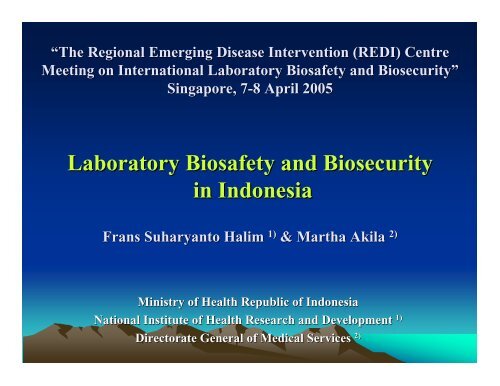Laboratory Biosafety and Biosecurity in Indonesia - Sandia National ...
Laboratory Biosafety and Biosecurity in Indonesia - Sandia National ... Laboratory Biosafety and Biosecurity in Indonesia - Sandia National ...
- Page 4 and 5: I. Introduction …. (1)Geography,
- Page 6 and 7: I. Introduction …. (2)Geography,
- Page 8 and 9: Table of contentI. IntroductionII.R
- Page 10 and 11: Decree of the Minister of Health of
- Page 12 and 13: Classification of lab. based on its
- Page 14 and 15: The other related regulations :•
- Page 16 and 17: III. Biosafety and Biosecurity Effo
- Page 18 and 19: III. Biosafety and Biosecurity Effo
- Page 20 and 21: IV. National Preparation Efforts1.
- Page 22 and 23: V. Future threats* Geographic condi
- Page 24: VI. Conclusions1. The main regulati
I. Introduction …. (1)Geography, climate <strong>and</strong> population• <strong>Indonesia</strong> consists of 5 major isl<strong>and</strong>s, +/-3,000medium <strong>and</strong> 13,677 small isl<strong>and</strong>s• The location is between two cont<strong>in</strong>ents• The total area is 5,193,250 km 2(39% l<strong>and</strong> <strong>and</strong> 61% sea territory)• It has dry <strong>and</strong> ra<strong>in</strong>y seasons• The range of temperature is from 20 o C to30 o C <strong>and</strong> the humidity is from 65% to 90%
Map of <strong>Indonesia</strong>
I. Introduction …. (2)Geography, climate <strong>and</strong> population• <strong>Indonesia</strong> is divided <strong>in</strong>to 33 Prov<strong>in</strong>ces, 441districts, 5.175 sub-districts <strong>and</strong> 66,721villages• Total population <strong>in</strong> 2003/2004 is 216,200,000with pop. density of 113 persons per km 2• There are > 300 ethnic groups
I. Introduction …. (3)Biological threats <strong>in</strong> <strong>Indonesia</strong>* Pattern of possible “Biological Threats” (WHO):anthrax, botulism, HF, smallpox, plaque<strong>and</strong> tularemia* Other Infectious Diseases :tuberculosis, malaria, cholera, typhoid fever, HIV-AIDS, <strong>in</strong>fluenza
Table of contentI. IntroductionII.RegulationIII. <strong>Biosafety</strong> <strong>and</strong> <strong>Biosecurity</strong> EffortsIV. <strong>National</strong> Preparation effortsV. Future threatsVI. Conclusions
II. RegulationThe ma<strong>in</strong> regulation on laboratory safety:• Decree of the M<strong>in</strong>ister of Health ofThe Republic of <strong>Indonesia</strong> Number1244 of 1994 regard<strong>in</strong>g Guidel<strong>in</strong>eson <strong>Biosafety</strong> <strong>in</strong> Microbiology <strong>and</strong>Biomedical Laboratories.
Decree of the M<strong>in</strong>ister of Health of The Republic <strong>Indonesia</strong>Number 1244 of 1994regard<strong>in</strong>g Guidel<strong>in</strong>es on <strong>Biosafety</strong> <strong>in</strong> Microbiology <strong>and</strong> Biomedical laboratories• Article I - Introduction• Article II - Classification of microorganism <strong>and</strong> laboratory• Article III - Management of Work-safety <strong>Laboratory</strong>• Article IV - General Guidel<strong>in</strong>esa. Generalb. Good <strong>Laboratory</strong> Practicec. Specimen managementd. Layout <strong>and</strong> facility of the laboratorye. Sterilization, dis<strong>in</strong>fection, decontam<strong>in</strong>ation, <strong>and</strong> waste laboratorymanagementf. <strong>Laboratory</strong> equipments <strong>and</strong> preventable hazardg. Health of laboratory workersh. Stipulation on support<strong>in</strong>g workersi. Transportation of specimens <strong>and</strong> <strong>in</strong>fectious materials fromlaboratory.
Decree of the M<strong>in</strong>ister of Health of The Republic <strong>Indonesia</strong>Number 1244 of 1994regard<strong>in</strong>g Guidel<strong>in</strong>es on <strong>Biosafety</strong> <strong>in</strong> Microbiology <strong>and</strong> Biomedical laboratories• Article V - <strong>Biosafety</strong> <strong>Laboratory</strong> 1 <strong>and</strong> 2• Article VI - <strong>Biosafety</strong> <strong>Laboratory</strong> 3• Article VII - <strong>Biosafety</strong> <strong>Laboratory</strong> 4• Article VIII - Chemical Agents : hazard <strong>and</strong> methodof security• Article IX - Radioactive agent : Hazards <strong>and</strong> methodof security• Article X - Method of laboratory security withanimal facility• Article XI - Other stipulations
Classification of lab. based on its function(accord<strong>in</strong>g to Health Lab. Directorate, DG of Medical Services, M<strong>in</strong>. of Health)1. Educational laboratory2. Service <strong>Laboratory</strong>3. Research <strong>Laboratory</strong>4. Production <strong>Laboratory</strong>
Classification of lab. based on its functionNo.Function of thelaboratory1. EducationTotal172.3.4.ServiceResearchProductionTotal463167
The other related regulations :• Law of the RI Number 23 0f 1992 regard<strong>in</strong>g health (article 22 & 23)• Regulation of the M<strong>in</strong>. of Health RI Number949/Menkes/SK/VIII/2004 regard<strong>in</strong>g guidel<strong>in</strong>es for earlypreparedness system of <strong>in</strong>fectious diseases outbreaks• Decree of the M<strong>in</strong>. of Health RI Number 424/Menkes/SK/IV/2003regard<strong>in</strong>g determ<strong>in</strong>ation of SARS as a potential outbreak disease<strong>and</strong> the guidel<strong>in</strong>es to manage it.• Decree of the M<strong>in</strong>. of Health RI Number 1116/Menkes/SK/VIII/2003regard<strong>in</strong>g guidel<strong>in</strong>es for Epidemiology Surveillance System• Decree of the M<strong>in</strong>. of Health RI Number 1479/Menkes/SK/X/2003regard<strong>in</strong>g guidel<strong>in</strong>es for Epidemiology of Communicable <strong>and</strong> NoncommunicableSurveillance System• Decree of the M<strong>in</strong>. of Trade <strong>and</strong> Industry RI No. 254/MPP/Kep/2000regard<strong>in</strong>g the export <strong>and</strong> import of certa<strong>in</strong> dangerous materials,<strong>in</strong>clud<strong>in</strong>g chemical <strong>and</strong> biological agents
Table of contentI. IntroductionII.RegulationIII. <strong>Biosafety</strong> <strong>and</strong> <strong>Biosecurity</strong> EffortsIV. <strong>National</strong> Preparation effortsV. Future threatsVI. Conclusions
III. <strong>Biosafety</strong> <strong>and</strong> <strong>Biosecurity</strong> Efforts …(1)Beside <strong>Biosafety</strong>, , why the <strong>Biosecurity</strong> isalso important?Some conditions <strong>in</strong> our country need more attention:• Geographic condition• Some diseases as “Biological Threat” (WHO) areendemic <strong>in</strong> certa<strong>in</strong> areas of <strong>Indonesia</strong> i.e. anthrax,dengue hemorrhagic fever, <strong>and</strong> plaque.• Big proportion of population with low <strong>in</strong>come capacity,poor h. environment condition & h. status• There are some separatist or extremist groups <strong>in</strong>certa<strong>in</strong> parts of <strong>Indonesia</strong>.
III. <strong>Biosafety</strong> <strong>and</strong> <strong>Biosecurity</strong> Efforts …(2)<strong>Biosafety</strong> & <strong>Biosecurity</strong> efforts have been done:• Tra<strong>in</strong><strong>in</strong>g regard<strong>in</strong>g Weapons of MassDestruction (WMD) April 2003 <strong>in</strong> Jakarta<strong>in</strong> collaboration with US EmbassyJakarta• <strong>National</strong> Sem<strong>in</strong>ar on Bioterrorism, July2003, <strong>in</strong> Jakarta, by M<strong>in</strong>istry of Science& Technology.
III. <strong>Biosafety</strong> <strong>and</strong> <strong>Biosecurity</strong> Efforts…. (3)• Outbreak Response Team established by DG ofCDC <strong>and</strong> NIHRD of MOH.• Early Warn<strong>in</strong>g & Outbreak Response System(EWORS) a software created <strong>and</strong> tried out byNIHRD & CDC of MOH <strong>and</strong> Namru-2 2 (WHOCollaborat<strong>in</strong>g Centre for Emerg<strong>in</strong>g InfectiousDiseases)• Other efforts: <strong>Indonesia</strong> as a coord<strong>in</strong>ator ofAsean web-based based network<strong>in</strong>g on EID Asean Disease Surveillance. Net
Table of contentI. IntroductionII.RegulationIII. <strong>Biosafety</strong> <strong>and</strong> <strong>Biosecurity</strong> EffortsIV. <strong>National</strong> Preparation effortsV. Future threatsVI. Conclusions
IV. <strong>National</strong> Preparation Efforts1. Strengthen national capacity build<strong>in</strong>gfor biosafety <strong>and</strong> biosecurity <strong>in</strong> thelaboratories:- personnel- equipment- law enforcement & sanctions2. Enhanc<strong>in</strong>g collaboration <strong>and</strong>network<strong>in</strong>g with<strong>in</strong> Asean <strong>and</strong> withdeveloped countries
Table of contentI. IntroductionII.RegulationIII. <strong>Biosafety</strong> <strong>and</strong> <strong>Biosecurity</strong> EffortsIV. <strong>National</strong> Preparation effortsV. Future threatsVI. Conclusions
V. Future threats* Geographic condition of <strong>Indonesia</strong>* Possibilities used by Separatist <strong>and</strong>Extremist Groups/Organizations* Possibility of some scientistsjo<strong>in</strong><strong>in</strong>g those extremist groups
Table of contentI. IntroductionII.RegulationIII. <strong>Biosafety</strong> <strong>and</strong> <strong>Biosecurity</strong> EffortsIV. <strong>National</strong> Preparation effortsV. Future threatsVI. Conclusions
VI. Conclusions1. The ma<strong>in</strong> regulation on laboratory safety needto be revised2. Some efforts have been done regard<strong>in</strong>g biosafety<strong>and</strong> biosecurity3. There is a need for national preparation efforts to strengthencapacity build<strong>in</strong>g <strong>and</strong> enhanc<strong>in</strong>g collaboration <strong>and</strong>network<strong>in</strong>g with<strong>in</strong> Asean <strong>and</strong> with developedcountries4. Future threats are to be considered as part of thepreparation efforts of biosafety <strong>and</strong> biosecurity <strong>in</strong> thelaboratory.



